Where to go in Switzerland on a short trip: Alps, lakes, and cities
Switzerland is an extremely popular country for those planning multi-stop tours around Europe, yet very few potential first-time visitors actually know specifically where they want to go. Everyone seems to know that it has the most beautiful views of the Alps and some very impressive cities, but there are actually many misconceptions among casual trip planners, so I’d like to clear most of that up below. The places to visit in Switzerland are not obvious until you’ve been there yourself or done many hours of research, so the list below should be a short cut.
I get hundreds if not thousands of itinerary questions for people who are considering a Eurail trip around Europe, and most people just include the word “Switzerland” among a list of cities like Paris, Rome, and Berlin that they want to visit. So where in Switzerland should you go if you can only make a few stops at most? I’ll answer that question below. You’ll mostly want to focus on the best choices for Swiss Alps trips, which I’ll go over below.
Note: This article was expanded and updated in February, 2024.
Switzerland is about outdoor views rather than city visits
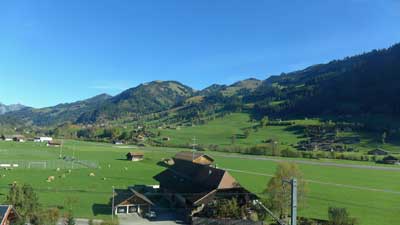
Geneva is a very famous city (though not for tourism reasons) on a lovely lake of the same name, but it’s also notoriously dull and lacking distinction. Rick Steves puts it well by saying that “Geneva is pleasantly situated on a lake, like Buffalo or Cleveland.” The point is, you don’t want to go to Geneva unless you’ve got something specific in mind that you want to see there. There are much better places to visit in Switzerland if your time is limited, or even if it’s not.
Switzerland's cities in summary
Zurich – The largest city, very expensive, geared towards business travelers. It’s generally a pretty and very well-run city that you would enjoy if you visited, but it’s not nearly as interesting as the likes of Vienna, Munich, or of course Paris.
Geneva – Second largest city, in the French part of the country, no major sights. Again, if you visited you’d be very impressed by it and get some great photos, but it’s not worth your time unless you know someone there. There’s an impressive fountain in the lake and you can usually see it from the train as you go through the city, but it’s not really worth going there and staying more than an hour or so.
Basel – Bordering France and Germany, no major sights. It has the famous art market each year, and aside from that it’s even duller than the ones above. Again, if you visited you’d be impressed, but if you later compared photos with friends who went to the Lauterbrunnen Valley instead, you’d kick yourself for going to Basel.
Lausanne – Near Geneva in the French part of the country, very hilly, and certainly more interesting than Geneva.
Bern – The capital, compact, on a lovely river, some interesting sights and the best Swiss city to get a feel for the culture. Bern is fairly close to Interlaken (which we will discuss below) and it can be a great day trip from there, especially on a day where it is foggy and/or rainy in the mountains (and this happens a LOT).
How much time and which Swiss cities to visit?
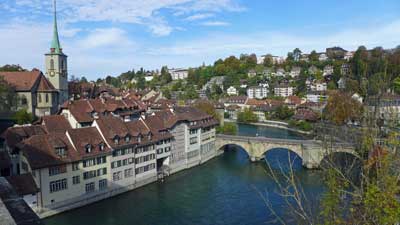
Many people (me included) don’t feel as if they’ve scratched the surface of a new country if they haven’t spent at least a day or two in the largest city. Zurich is certainly pleasant and a useful transit hub so spending one or two nights there wouldn’t be a major mistake. But Zurich isn’t even close to being a city like Paris, Rome, Berlin, Amsterdam, or even Vienna. If you skip it in favor of spending more time in the Swiss Alps, you won’t be missing much.
The 2 Best places to visit in Switzerland for short visits
Interlaken – If you want the best possible Alpine views and activities, head to the Interlaken area, which will be described in detail below. This is my favorite of all places to visit in Switzerland and it will probably be yours as well.
Lucerne – The traditional Swiss tourist retreat, Lucerne is a small city with interesting culture and sights, that is gorgeously set on a lake with plenty of top activities surrounding it.
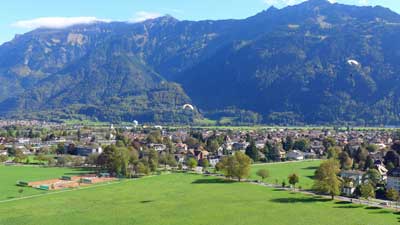
>>>Interlaken and Lucerne: Which to choose and how long to stay in each?
The article linked above will give you more details on which to choose and how long to spend in each place.
What about Zermatt for Alpine views?
Zermatt is a remote car-free village in southern Switzerland that is famous for being the place to see the Matterhorn mountain. It’s also a busy ski resort area, and aside from that, there isn’t much to see or do here. It’s on a private rail line, so it’s more complicated and usually more expensive to reach than Interlaken.
In other words, unless you’ve irrationally placed “Seeing the Matterhorn in person” on your so-called bucket list, skip Zermatt and head to Interlaken on a shorter visit. You won’t be sorry. If you already have enough time in your visit for the main sights around Interlaken and Lucerne and you want to also see the Matterhorn, then by all means go and you’ll enjoy it. There are quite a few other car-free villages in the Lauterbrunnen Valley near Interlaken, so they are not as novel in Switzerland as one might expect.
A weekend in Switzerland? What to see in 3 days
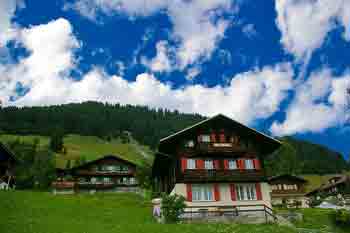
One challenge is that neither has an international airport so you’ll either be flying into Zurich or perhaps Geneva.
Train times from Zurich to Lucerne to Interlaken and back
- Zurich Airport to Lucerne: 1 hour 10 minutes by train
- Lucerne to Interlaken: 2 hours by train
- Interlaken to Zurich Airport: 2 hours 15 minutes by train
As you can see with the travel times above, Zurich Airport to Lucerne is a fairly short trip, but once you add Interlaken into the mix (even if you skip Lucerne) the travel time starts to add up for a weekend visit. With this in mind it’s probably best to just choose one of them and save the other one for another trip.
Lucerne is gorgeous, but the Lauterbrunnen Valley near Interlaken is really the star of the show, so I’d recommend going there first and doing Lucerne on another trip.
What about the Swiss Travel Pass?

The bottom line is that if you are coming to Switzerland for at least 3 days and you want to take 2 or more of the amazing scenic rail journeys that the country is famous for, the travel pass is probably a good deal. It also provides 50% discounts on the Schilthorn cable car and 25% off the Jungfraujoch mountain railway. Both of those are quite expensive on their own, but extremely worthwhile, so the discount is helpful.
The Half Fare Card is probably a better deal for most people
The Swiss Travel Pass is a good deal for those who are going to be spending at least 2 or 3 days riding the rails and seeing Switzerland that way. But if you are mostly going to be focusing on Interlaken and Lucerne and the mountain sights, the Half Fare Card is the best option. For CHF120 (about US$134) you get the card that is good for 30 days and gives you a 50% discount on all trains, cable cars, mountain railways, and other sights and attractions. If you are doing either Schilthorn or Jungfraujoch, the Half Fare Card practically pays for itself with just one of those.
>>>Buy the Swiss Half Fare Card
Many people have questions about the Swiss Half Fare Card so I will explain it a bit here. You can actually buy half price train tickets for travel within Switzerland any time you want and you will see that option when you go to buy them online. The only thing is you have to have and present a valid Half Fare Card when you get on the train and are asked to see your ticket. In other words, you can buy a half fare train ticket today and buy a Half Fare Card just before you get on that train months in the future, and you are fine.
How and why visit the area around Interlaken
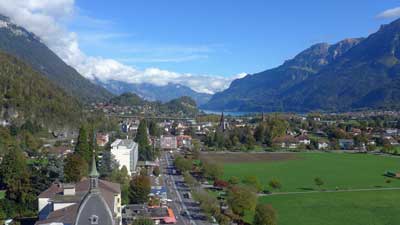
You can see everything discussed below by actually staying in a hotel in Interlaken, but it’s not the Alpine experience that you get if you stay in one of the small villages nearby. You can reach those villages in 20 to 40 minutes from the Interlaken Ost (East) train station, and it’s much easier than it sounds.
The 3 best places to stay to visit the Swiss Alps
Lauterbrunnen – A private train line runs from Interlaken Ost station to the end of its line in Lauterbrunnen. There’s a lovely waterfall here and great hiking trails, but you should probably only stay here if you can’t get to one of the villages mentioned just below. It’s a great little transit hub and it’s definitely gorgeous, so it can be worth a night if you’ve got one to spare.
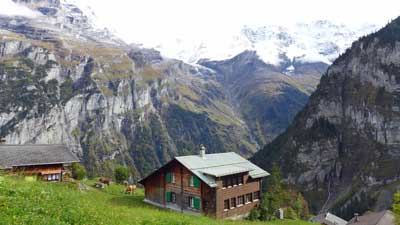
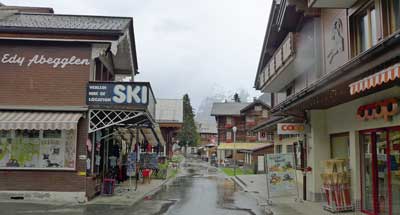
Where to stay in Interlaken and the Lauterbrunnen Valley (with pics)
I get so many questions about where to stay in the Interlaken area that I decided to write a longer version of it and load it with huge photos so readers can get a better feel for each option. I also included recommendations for affordable and well-located photos in each area.
>>>Where to stay in Interlaken and the Lauterbrunnen Valley New for 2024!
The unforgettable things to see here (if the weather is decent)
Schilthorn observation deck and restaurant
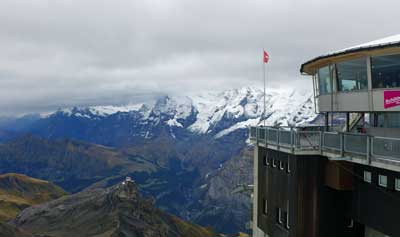
There is a rotating restaurant (with prices similar to normal Swiss restaurants) and a bizarre and anachronistic James Bond attraction based on it being a key location in the 1969 movie On Her Majesty’s Secret Service. The Bond thing is included with the lift, and it’s worth a look.
But the main thing you come here for is the 360-degree view from one of the highest peaks in Europe. Again, the weather here is key, but fortunately all the locals track the visibility on a minute-by-minute basis. If it’s clear up top while you are in the area, it would be a terrible shame to skip it based on the high price. But even if it’s cloudy up top, there are still plenty of wonderful things to see and do in the villages below.
Jungfraujoch observation area
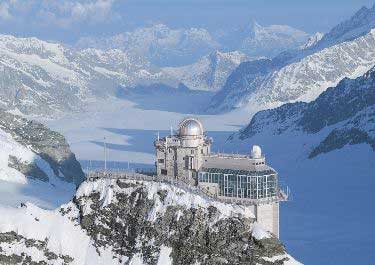
The views from the top are similar to the views from Schilthorn, from the other side of the Lauterbrunnen Valley. Once on top you can have lunch, hike, or even go sledding. It’s also quite expensive at nearly US$200 round-trip unless you have a Swiss Pass or a Eurail Pass for discounts, and it takes most of your day, but you’ll never forget the views from the top.
Harder Kulm mountain and Two Lakes Bridge Observation Deck
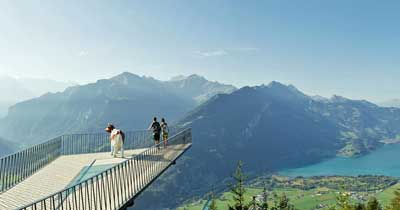
There’s a revolving restaurant about 10 minutes’ walk from the station at the top, which is definitely an unforgettable place for lunch if you’ve got time. It’s not as expensive as you might expect, at least compared to normal restaurants in Switzerland.
The Harder Kulm Railway goes from early April through late November each year. If you are only in Interlaken for one day and/or you are on a strict budget, this is the fastest and best way to get amazing Alpine views in the area.
Getting from Interlaken to Gimmelwald and Mürren
Getting up to these villages sounds complicated and time consuming, but it’s actually fast and easy once you get there. This little guide should help.
Arrive in Interlaken
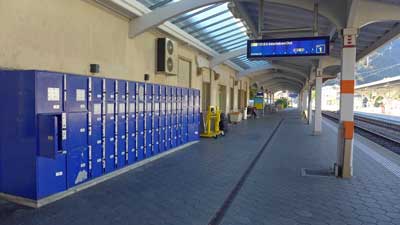
Once you arrive at the Interlaken Ost train station, head for the ticket windows in the office and buy a ticket to your final destination (Lauterbrunnen, Gimmelwald, or Mürren). Eurail passes are good for 25% discounts on the rest of the trip, but not for the whole thing.
From Interlaken Ost to Lauterbrunnen
The private train leaves Interlaken Ost every 30 minutes and arrives in Lauterbrunnen 20 minutes later. If you are staying in Lauterbrunnen then you are probably walking distance from your hotel when you reach the station.
From Lauterbrunnen to Gimmelwald
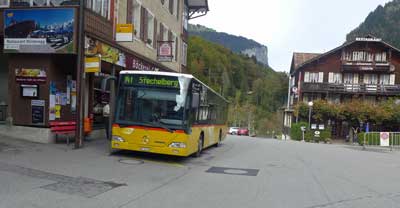

From
Gimmelwald to Mürren
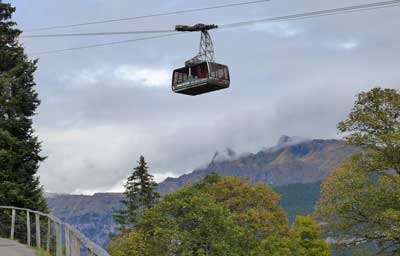
Recommended hotel and hostel in Gimmelwald
I get asked all the time about where to stay in Gimmelwald, so here it is:
Hotel: Esther’s Guesthouse
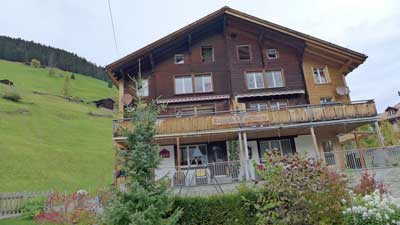
It’s run by Esther, as you might guess, and she is very friendly speaking excellent English. Each room is different and the place feels like a mountain cabin, because it is. She offers an excellent buffet breakfast in the morning, which you have to order the night before. It’s not cheap, but it’s worth it because it’s hearty and there are no other good options nearby.
Book as early as possible because this place is often the first place to sell out in Gimmelwald.
Hostel: Mountain Hostel Gimmelwald
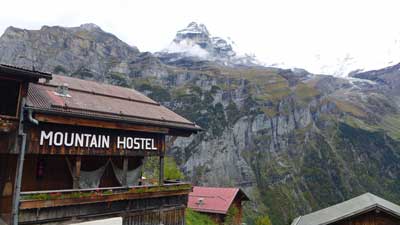
You won’t believe the views from this place, which are the same as from Esther’s except a bit lower and more unobstructed. This place also has a busy bar and restaurant that is basically the only “nightlife” in Gimmelwald. Many hikers get to bed early in this tiny village, but if you want to have a couple drinks and order a pizza or some local options, this is the place to go.
Again, book early because this place is always sold out.
Lucerne and what to do there
Luzern, as it’s spelled locally, is the other traditional holiday destination in Switzerland. Unlike Interlaken, Lucerne actually qualifies as a small city rather than a small resort town, so it’s a very nice contrast and very worthwhile. We have a new article with advice on where to stay in Lucerne and it should be helpful.
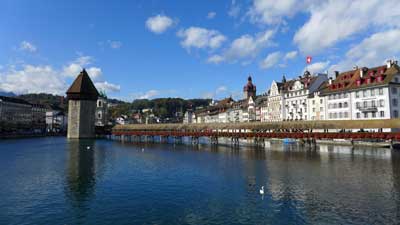
However, unlike Interlaken, the town of Lucerne itself is a great attraction and worth at least a day of exploration. This has always been a rich area so you can expect to find all of the high-end shops and boutiques along the small streets just north of the lake, but there are also many traditional shops and things to see that will appeal to anyone.
Recommended hotel in Lucerne
>>Hotel Des Alpes (3 stars with an amazing location and view)

If this place is booked, which is often the case, then book a hotel as close to it as you can find or afford. The whole historic part of town surrounding it is lovely, with restaurants, bars, and high-end shops. There are also a couple of nearby supermarkets where you can buy inexpensive alcohol and picnic supplies to keep other costs down.
Spend a day in Lucerne itself
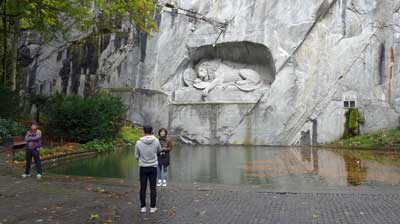
Most of the interesting part of Lucerne is in the area behind those restaurants, and it’s certainly worth doing a self-guided walking tour if not a guided one. Heading farther east you’ll come to another older part of town where the famous lion statue is located. You can’t visit Lucerne without having a look at the lion, and fortunately it’s easy and quick to reach (and it’s free).
Take a lake cruise of some kind
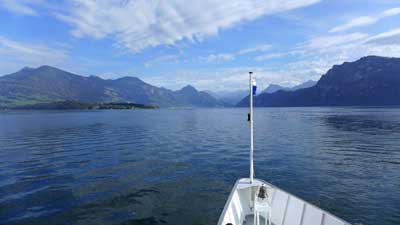
Especially in nice weather, even the short lake tour is lovely, and if you have more time you can jump off at Vitznau and do the scenic hike up Mount Rigi. There are also small lakeside villages that are ideal for a stroll and lunch stop. Long story short, there are dozens of interesting sightseeing options that are available using part of the boat tour, and the views all around are wonderful.
Visit Mount Pilatus
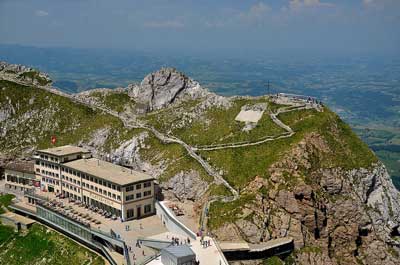
You can take the cogwheel train up and have a more or less flat hike around the summit area, and then take the gondola and cable car back down again. You can do them in the other order, and the cost is the same either way. At around US$65, this is not a cheap hike, but like most everything in Switzerland, the quality is high so it doesn’t feel like a rip-off. You can reach the cable car in 10 minutes on a public trolly bus from Lucerne.
Visit Mount Rigi
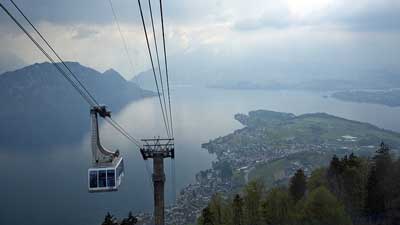
Unlike the other peaks mentioned in this article the Swiss Travel Pass covers both ways to get up and down for free. The others are 50% off with the Swiss Travel Pass or Half Fare Card, except for Jungfraujoch, which is only 25% off with the Swiss Travel Pass and still 50% off with the Half Fare Card.
Visit Mount Titlis
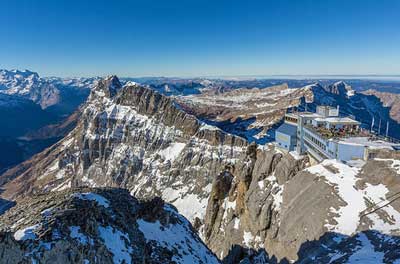
You can reach Titlis by taking a 43-minute train ride from Lucerne to Engelburg and then taking the cable car up from there. As with the others, it’s wise to check the weather immediately before you are going to depart because it can be foggy or cloudy any time of the year, but usually not for whole days at a time.
Additional photo credits
Jungfraujoch by cupweuro on Flickr, Pilatus by Tony Fernandez on Flickr, Rigi by Kosala Bandara on Flickr, Titlis by PaulSchliebs on Flickr

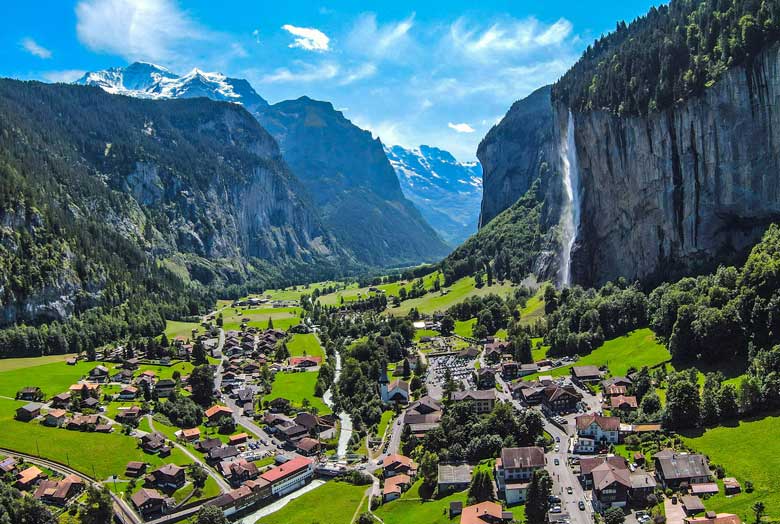
Hi Roger more or less my trip has been finalized. Just need your input on the best rail method
We intend taking the train as follows upon our arrival in Geneva
1) Geneva Airport to Montreux
2) Montreux to Spies
3) Spies to Lucerne
4)Lucerne to Zurich
5) Zurich to Salzburg
6) Salzburg to Vienna
When searching there is the SBB and Raileurope . Should i book online or do it on arrival? They ask if i have one year Half pass card. Should I get the 30 day or one year?
Your assistance in the rail system will be greatly appreciated
Thank you
Kind Regards
Rajitha
Rajitha,
For all of the train rides within Switzerland I would either buy them on SBB.ch or buy them when you get there. It’s worth checking online because once in a while they will offer a promotional fare for some routes, and if they do it’ll be even cheaper. But if it’s just the normal fares then those are the same whether you buy 30 days in advance or just before the train leaves.
As for the Zurich to Salzburg train, I would definitely buy it as soon as possible because it will be cheaper the earlier you buy it. I believe the Salzburg to Vienna train trip is the same in that it’s cheaper to buy earlier, and for that you’d obviously want to buy from the Austria rail website.
And I would definitely get the 30-day Half Fare Card for Switzerland. You can buy it online and print it at home for free, or buy it when you get there for the same price. If you want to buy those Swiss train tickets online there will be a field in the purchase process that asks you which discount you have. You can pull the little slider down to Half Fare and buy tickets at half price that way. You don’t even have to own a Half Fare Card at that point, but when you board the train they will ask to see your ticket AND a valid Half Fare Card, so you just have to make sure you have one on you before you ride. Let me know if you have any other questions. -Roger
Hi Roger!
Wow i have read most of the Q’s and A’s on this website. Just a few questions. Me and my wife is planning for our be-lated honey moon trip to Europe. We are thinking about driving from Milan to Switzerland (3 days total in Switzerland). I would love to visit the Alps but we might not have the time. If you were in my shoes where would you go?
Andrew,
That is a lot of Qs and As to read, but thanks. It would be helpful to know what time of year you’ll be doing this, but really Switzerland is good any time of the year. I haven’t driven through the Alps from Italy to Switzerland, though it sounds like it could work well. I know the roads through the Alps are fairly busy and I believe there are some tunnels and toll roads, but at least they are well maintained and have a lot of trucks on them all the time. The views from the trains on that route are amazing, and I think from the car they won’t be as good, yet still very nice.
If you only have 3 days I would go to the Interlaken area, as discussed at length above. Many hotels in that area actually have free parking, and you can reach many of the better viewpoints and hiking trail heads by car. You’ll have to pay to park at most of them, but it would still be cheaper than taking the train if you are already in your own car. I’m happy to help with more information if you have specific questions. -Roger
Hi Roger
Further to my previous messages.
I have rough itinerary
Arrive in Geneva 13th . Stay 1n in the lake Geneva area.
Travel to Interlaken by train 3n in Interlaken area ( what’s the best area to stay in Interlaken ? )
Take the train to Lucerne stay 3N and then move to Zürich for a night or so.
Take the train to Salzburg 3n in Salzburg and then to Vienna and 3N in Vienna and depart back to SRI Lanka from Vienna
Rajitha,
Your itinerary looks great. As for Interlaken you might think about staying one or two nights in either Gimmelwald or Murren, and one or two nights near one of the train stations in Interlaken. Those options are all described in the article above. The Interlaken Ost (east) train station is a better travel hub because that’s where you get the train to Lauterbrunnen and then to Gimmelwald or Murren or Wengen, but there are more hotels close to the Interlaken West train station. All trains stop at both stations and if you are staying in Interlaken they give you a local travel card good for free bus travel as well as free trips on the train between the two stations, which are about 5 minutes apart. Let me know if you have any other questions. -Roger
Very helpful and thorough article, thanks!
My question is our itinerary is still in the works, but
Wanted to ask your opinion on visiting Switzerland and Amsterdam from Paris.
What is the most workable schedule in your opinion?
We are flying in and out of Paris, but wanted to visit Interlaken
and Amsterdam in between.
Our dates are April 19-May 1st
Planning to stay five days in Paris and spend the rest in Switzerland and Amasterdam, and be back by April 30th in Paris and fly out on May 1st back to USA.
What country should we go to first coming from Paris? We don’t mind taking the train over flying since the views would be worth it. Should we get the Eurail pass for these destinations?
Thanks in advance!
Jamie
Jamie,
That sounds like a fantastic trip and I really love all of those places. Between Paris and Amsterdam the train takes only 3 hours 20 minutes and the scenery is fairly plain because it’s all flat. Between Paris and Interlaken the train takes about 5 hours 30 minutes and the scenery within Switzerland is excellent. But the train between Amsterdam and Interlaken takes over 9 hours so it’s not worth it, partly because flying is actually cheaper as well. So you could either start in Paris and then take a train to Amsterdam for 3 days and then fly to Zurich and take a train to Interlaken for 2 or 3 days, and then take the train back to Paris. Or you can do it in the reverse order. I can’t think of any strong arguments to do it in one order or the other, so it’s really up to you.
Eurail Passes are good for long trips where you aren’t sure when and where you want to go next. The per-day cost of a Eurail Pass is actually quite high, so they really only save you money compared to the cost of buying a ticket with very little notice. For you it will be much cheaper and better to just reserve your train tickets as far in advance as possible (up to 3 months or so). Those tickets will be cheaper than any Eurail Pass and you’ll have many choices of departure times. Buy them from the official rail websites of each country, and you can find links to those plus rules on this article about buying European train tickets in advance.
However, for your time in Switzerland you’ll probably want to buy a Half Fare Card. They cost CHF120 per person and they literally give you a 50% discount on every train, bus, boat, and cable car ride in Switzerland. That sounds like a lot of money for a short visit, but if it’s almost impossible to visit the Alps in Switzerland and pay less than CHF240 in a few days. It’s explained more on my article on the Swiss Travel Pass. Let me know if you have any other questions. -Roger
Hello Roger,
Greetings. First of all, thank you for the wonderful information.
In April end, I am planning for 6 days to cover Switzerland and Venice.
I depart from Brussels. Can you provide me an itinerary?
If you had already provided above, kindly excuse and point me to the post.
Forgot to mention that my return is to Brussels.
Regards,
Mani
Mani,
From Brussels I would fly to Zurich to start with. You could take a train from Brussels all the way to Interlaken, but it takes around 8 hours and requires at least 2 or 3 changes along the way, plus it would be more expensive than flying. So fly from Brussels to Zurich and I would first go to Lucerne and spend around 24 hours there. Then take a train to Interlaken and spend 3 days or so there. Then you can take a train to Venice on an extremely scenic journey through the Alps and then a change of trains in Milan. Spend 1 or 2 days in Venice and then fly back to Brussels from there or from nearby Treviso Airport. Venice is small enough to enjoy in about 24 hours, but two days there would be nice if it’s your only stop in Italy. Let me know if you have any other questions. -Roger
Hello Roger, thank you for the inputs. I am replying to my post of 17th Feb and your response. I’m afraid this post is going to be a little long too. 🙂
We have booked our return tickets from Luxembourg to Zurich from 20 – 23 March. The flight lands at 11.30am on 20th in Zurich and return flight departs at 1700 hours on 23rd from Zurich.
Q1. Is it possible to proceed directly to Murren/Gimmelwald from the airport? If yes, should we do that?
Q2. Would it be worthwhile going to Lucerne from the airport and then heading to Murren the next day? Will we be able to explore Lucerne properly in half a day because we probably will not return again to Lucerne.
Q3. We are vegetarians. Going by that “constraint”, which place would you suggest amongst Lauterbrunnen/Gimmelwald/Murren?
For the sake of repeating myself, we are looking forward to experiencing the Swiss Alps and scenic beauty. Originally we had not planned a visit to either Schilthorn or Jungfraujoch as it would be both time-consuming and expensive. Since it’s only a 3.5 day trip, we want to make maximum use of it.
Q4. Since we have not gotten an evening flight out, would you suggest we reach Zurich on 23rd morning and spend the day exploring Zurich?
Q5. How can we fit a visit to Rhine falls in this time?
I may bother you again, if need arises 🙂
Rajshree,
1. Yes, you can take a train from Zurich Airport to Interlaken Ost station and then change there for a local train to Lauterbrunnen that takes 20 minutes and leaves every half hour. Then follow the instructions in the article above about getting to Gimmelwald or Murren. The cable cars run from around 6am until after 10pm, every 30 minutes, so you can come and go whenever you like. You should actually be able to buy a ticket at Zurich Airport all the way to Gimmelwald or Murren that includes all trains, the bus, and cable car. In case they can’t sell you that whole ticket there you can buy the last part in Interlaken. And yes, you might as well go directly there.
2. Lucerne is much closer to Zurich Airport and doing that would work well and I think it would be worthwhile. You could be in Lucerne by 2pm or so, and you’d probably have time for a boat cruise after you check into your hotel. Again, the boat cruises leave from directly across from the train station, so staying in that area is convenient. And Lucerne in the evening is really magical, which isn’t really true of Interlaken itself.
3. Gimmelwald only has 2 or 3 restaurants in total, but there are dozens in Murren and quite a few in Lauterbrunnen. I think I would choose Murren and there are many veg-friendly restaurants there. The Swiss Alps are extremely popular with tourists from India so there are quite a few actual Indian restaurants, and many others that are veg-friendly and very sensitive to dietary issues.
4. You could visit Zurich for the day on your last day, but I’d only recommend it if you have specific things you want to see there. Zurich is nice enough and a pleasant place to spend a day, but almost everywhere else in Switzerland has amazing scenery and so it’s unclear whether it’s worth spending a day in a crowded city rather than spending the day seeing more stunning views.
5. You could go to Rhine Falls directly from the airport, or perhaps on your last day. Otherwise it would take quite a bit of effort to squeeze it in. Have a great trip. -Roger
Hi Roger, thanks for your quick reply. Sincerely appreciate it. I will leave hubby to explore Basel and cities & town around it on his own while I am working. If we were to take out a night in Zurich, where would you recommend we park that extra night? Interlaken or Lucerne? I am for Interlaken actually.
Selina,
That is an interesting question. The sights around Interlaken are more dramatic and memorable than those around Lucerne, but the city of Lucerne is far more charming than the town of Interlaken. So it really depends on whether you want more time up in the mountains, or a bit more time in a lovely and photogenic city. Either one will be great. -Roger
Hi Roger, came across your article while doing research on Switzerland and found it interesting. I go to Switzerland annually for work, Baselworld. But have not really travelled around other than to Zermatt last year to scale the Breithorn. This year, I’ll be there again for work in March and hubby is coming over to join me. He’s never been anywhere further than 6-7h flights from Singapore. I want to show him the best of Switzerland and to be able to do some outdoor activities. I know the period we’re there is not the best for outdoor other than snow activities. We’ll be departing from Basel on 26 Mar afternoon. We will be driving (Swiss colleague’s car) and departing from Zurich on 1 April. How many days would you recommend if we’re to do Basel-Bern-Interlaken-Lucerne-Zurich? My initial plan is 1N in Bern, 2N Interlaken, 2N Lucerne and 1N Zurich. What do you think? Also, would it be worthwhile for us to get the rail passes as well so it’ll be easier to visit the alps & various attractions while in the various places so we don’t have to drive and probably can’t drive everywhere. Hope to hear from you. Thank you.
Selina,
I think your plan to spend those 6 nights is pretty much perfect. Bern is lovely but one day there is enough, especially considering how amazing the Alps towns are. The only thing I’d suggest is to consider dropping Zurich altogether. Zurich is a bit more interesting than Basel, but not by much, and it’s also very expensive. But mainly it’s that Interlaken and Lucerne are so amazing that it’s better to maximize your time there. The roads in Switzerland are well maintained so it should be easy to drive straight to the Zurich Airport on the day that you leave, unless you have to return the car somewhere else.
Normally I would very much recommend doing this by train and also buying a Half Fare Card, but if you have access to a car for free (or cheap), I would probably skip the trains for the most part. In other words, if you are already driving between all of those cities, it’s probably cheaper and easier to just keep using the car. Interlaken is not very dense so many of the hotels in the center of town also have free (or cheap) parking. In Bern and Lucerne you’ll probably have to pay to park, but it will still probably be much cheaper than adding in trains. Better still, you can actually reach many of the better viewpoints and attractions by car and pay a reasonable fee to park there. For example, you can drive to Stechelberg and park before taking the cable car up to Gimmelwald, Murren, and Schilthorn. The roads should be in pretty good condition as well, at least down in the valleys. It’s better to explore the higher elevations by cable car or the cogwheel trains and that sort of thing. Let me know if you have any other questions. -Roger
Hello Roger,
Thank you so much for this helpful advice. I want to ask you some question too regarding this.
I will be in Switzerland around mid April, and I already decided to spend 2 nights in Interlaken. Since this is my first time in Europe, I wish to visit other countries as well, and Switzerland is expensive 🙂
What I want to ask is :
1. Swiss Half fare card. I looked it up and it’s around 120 CHF. Does it mean that there is a balance of 120 CHF in the card that I can use until it’s used up? Or I have to buy separate tickets?
2. Grindelwad vs. Lauterbrunnen. So I will spend 1 full day to visit Jungfrau, that leaves me 1 free day to explore Interlaken, and I have a plan to visit either Grindelwad or Lauterbrunnen. Which do you recommend?
3. After that, I plan to take a flight to Amsterdam. Which airport do you suggest? I look at google map and it says Bern and Zurich are around the same distance I think.
Thank you.
Luqman,
I’ll be happy to try to help.
1. The CHF120 price for the Half Fare Card is just for the right to buy half-price tickets for 30 days starting when you validate it. You can buy half-price tickets online, and nearly all of Swiss train tickets are sold at half price because nearly all locals buy one of these cards each year. When you go to ride the train you then present your half-price ticket and they will also ask to see a valid Half Fare Card. You can even buy half-price tickets online in advance and then buy the Half Fare Card when you get there. You just can’t use the half-price tickets until you also have the card.
So the math is pretty easy in that the Half Fare Card pays for itself if you purchase more than CHF240 in train, bus, boat, and cable car tickets. Even on a 2 or 3-day visit it’s hard to stay below CHF240 if you are going up to the famous peaks or taking any cable cars, so it’s a good deal.
2. Lauterbrunnen is smaller and more charming than Grindelwald, and it has a more central location as well, but both of them are really gorgeous. From Lauterbrunnen you can also easily take the short bus ride to the cable car station in Stechelberg and then take the cable car up 5 minutes to Gimmelwald and then another one 5 minutes more to Murren. Both of these villages have far better views because they are on the side of the mountain rather than in the valley.
3. Zurich is the busiest airport in Switzerland and Geneva is next. Bern is quite small compared to the other two. Most likely you’ll find the cheapest fare on a nonstop flight out of Zurich, so I’d recommend that. And the airport has its own train station so you can go directly there without having to go into Zurich and get an airport train. But if you can get a cheap nonstop out of Bern, that could be even better. Have a great trip. -Roger
Thank you again Roger!